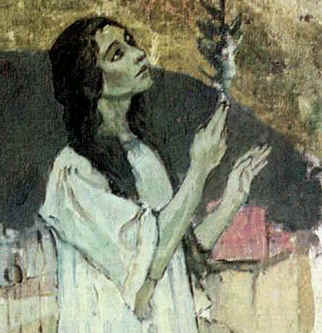Mikhail
Nesterov Saint Barbara the Martyr, 1924
 |
A major event
in late nineteenth-century Russian art history was the decoration
of the newly built Vladimir Cathedral in
Kiev
. In the 1890s Viktor Vasnetsov, Mikhail Vrubel and Mikhail Nesterov
big names in the Russian art world of those days adorned its walls
with murals and ornaments that today still rank among Russias and
Ukraines prime modernist religious art works.
Nesterov
was at this time on the very treshold of his artistic carreer. The Kiev
project formed a crucial episode for him. He experienced it as a dream
of a Russian renaissance and as an occasion for the revival of the
marvellous religious art of Russias early days.
At the same time this was a tumultuous period for him personally.
In the family of Adrian Prakhov, the supervisor of the work on the
Cathedral, he found a warm and bustling intellectual sanctuary. |
Twenty-three year old Nesterov was attracted most of all to what he
labelled the adornment of the family, his coeval Elena Prakhova. A
talented pianist and an intelligent woman, Adrians daughter did not
fail to impress several of her fathers guests, as is witnessed by
Viktor Vasnetsovs famous portrait of her. Nesterov and Prakhova were
even engaged for a while, but the relationship did not last.
A charming
proof of Nesterovs love for Liolia, as he calls Elena, is a 1894 portrait
that renders her in a poetic-idealist fashion. It was this portrait that served
as a prototype for his Cathedral mural of St. Barbara the Martyr in the same
year. The tragic figure of the virgin and saint who was murdered by her own
father for her conversion to Christian faith acquired a singularly meek and
tender depiction in Nesterovs portrait. He himself considered it his best
mural in the cathedral, and, as he contently asserted, the Prakhovs like
it too, especially Liolia.
As a whole, the
Vladimir murals marked a public breakthrough for Nesterov. They established his
reputation as an exquisite modern-day Russian icon painter. St.
Barbara the Martyr
caused a great deal of dust, however. Barbaras resemblance to her prototype
who was wellknown in well-to-do Kiev circles at the time proved too
obvious. After the remark of a certain grande
dame that she was not inclined to pray to Elena Prakhova, the mural was
censured by the Church Council. Nesterov was ordered to repaint his portrait in
a manner that contained less overt allusions to his personal idol.
That Nesterov
nevertheless stuck to his vision of Prakhova as an archetype of Saint Barbara,
can be inferred from Saint Barbara, painted a full thirty years later in 1924 without the
strict church supervision to which he was subjected in the 1890s. Rooted in
Byzantine and Russian iconographic tradition, this painting nevertheless offers
a highly personal perception of the Christian martyr. Apart from Saint Barbaras
classical attributes the sword with which her father had her beheaded and
the tower in which he kept her imprisoned Nesterov also echoes the pose and
facial expression of his original Barbara mural. With Prakhova as again its
manifest model, this painting breathes an even more intimate tenderness and
serenity than its 1894 counterpart.
picture:
fragment from mikhail nesterov's painting st. barbara the martyr (1894)
